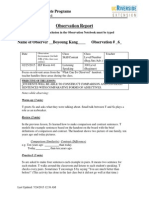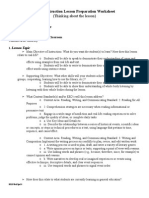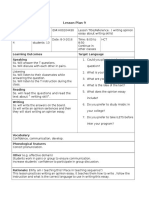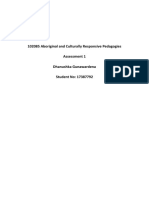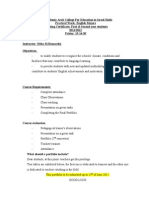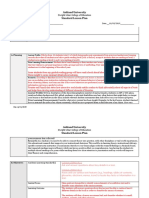Observation 2
Observation 2
Uploaded by
api-300213798Copyright:
Available Formats
Observation 2
Observation 2
Uploaded by
api-300213798Original Title
Copyright
Available Formats
Share this document
Did you find this document useful?
Is this content inappropriate?
Copyright:
Available Formats
Observation 2
Observation 2
Uploaded by
api-300213798Copyright:
Available Formats
TESOL Certificate Programs
Observation Notebook
Observation Report
Forms for inclusion in the Observation Notebook must be typed
Name of Observer____Huizi Zhao_____
Date
Observation Environment
(include URL if the class
was online)
Oct.17 classroom
Class
Skill/Content
Reading
Observation # 2_
Class
Teacher
Level/Number
(Beg./Int./Adv.)
400(int.)
Robb Hughes
Focus on relevant areas from the What Can Be Observed handout. Notice how the
teacher handles these areas during the class.
OBJECTIVE OF THE LESSON: STUDENTS WILL READ THE ADVANCED STORY;
STUDENTS WILL USE THE TARGETED PHRASAL VERBS TO WRITE COMPLETE
SENTENCES.
Notes while observing:
Background: After last class, the T gave some homework about a research of Romania,
where is Ann (main character) from. Then Ss needed to learn the vocabularies and list
the right order of outline for the story, and they came up with some questions based on
the story that they were going to ask other Ss.
T put Ss into pairs and let them compare their answers of homework.
Meanwhile, T write down look up/brought through/call up/rip out/mixed up in
on the black board.
After Ss are finished, T check answers with Ss and ask them what these phrase
means.
Ss come up with some explanations and they find out where are these phrase in
the story. Then T write down Ss ideas on the board.
(Now on the board:
Look out=see out a window
Brought up=carry to your location
Call up=call on a phone
Rip out=to remove with force
Last Updated: 11/10/2015 1:48 PM
TESOL Certificate Programs
Observation Notebook
Mixed up in=involved)
T asks Ss to give some complete sentences with phrases on the board.
Ss start to say sentences, meanwhile T corrects them with encourage attitude.
One S asks what is rip out, T picks one paper and tears apart it, and he tells the
S that the action is rip out
When T talks about mixed up in, he uses his personal experience to explain it.
Next, he put mixed up in and mixed up together and asks class what is the
difference between the two phrases. Ss say some their understandings and T pick
some key words from Ss to agree with them. Then, T asks Ss to make a sentence of
mixed up in.
T asks Ss what happened in chapter one, and Ss are answering.
In addition, T write down main point of the story on the board and list what Ss
say. Also, he leads Ss to say the right answer with some body language and facial
expressions.
After reviewing, T gives handout with questions about the story and he asks Ss to
work in groups and discuss these questions together.
Moreover, T asks these questions by picking Ss from each groups and he asks the
class if they agree with the answer.
T asks Ss to take out a piece of paper and rip out it in order to understand and
review what is ripping out a paper
Finally, the T asks Ss to answer some questions that are why do you think Ann
watches her neighbors?/ have you ever been curious about your neighbors?
Why? Or why not?/ what does the author mean? The T tells Ss do not copy
answers from the book, but they can use the ideas from him.
Class ends.
Last Updated: 11/10/2015 1:48 PM
TESOL Certificate Programs
Observation Notebook
What did you learn about teaching or learning from this lesson? Discuss your
observation focus, and the theory you have studied in your TESOL classes. Consider
the three levels of teacher reflection (surface, pedagogical, critical). (100-200 words)
I focused on how does the teacher teach the meaning of the words, and I noticed that the
teacher was very flexible and experienced that he was using some example to define the
situation of the word mix up in and he used body language to demonstrate what rip
out is. I think it is effective for students to understand how to use these words.
Furthermore, I think this class uses task-based approach and some principles from The
Direct Method. Because firstly the teacher gave some homework for Ss to scheme some
information before the class. Then, in class he listed target words on the board with
explanations and examples. In the case to use the target phrases fluency and accuracy, he
asked students to make sentence which is communicative practice, also he can check the
understanding of students.
References:
Lindsay, P (2000). Basic Question. In Teaching English Worldwide. (p. 3-15) Burlingame,
CA: Alta Book Center Publishers.
What activities/techniques from this class do you want to remember for your own
teaching practice? Discuss specific ways in which you could apply the techniques and
methods you saw. Discuss your future teaching environment and your students needs
and goals. (100-200 words)
I want to remember the way that the teacher give homework by search information about
the target passage before class. Because I think it is useful to develop students ability of
collecting news by themselves and it is also helpful to train their learning habits.
If I am going to teach oral speaking in an intermediate class, and my students want to
learn speaking strategies. My lesson plan is how to talk about a movie. I would give them
some dialogues and research to do.
Last Updated: 11/10/2015 1:48 PM
TESOL Certificate Programs
Observation Notebook
For example, as dialogues, I would give some jargon words about movie like CGI/
Blockbuster to students to look for. Then I would ask them to have a list of ways to
describe movie. In the class, I could combine their info with mine and ask them how they
usually describe a movie.
Last Updated: 11/10/2015 1:48 PM
You might also like
- Observation NotebookDocument35 pagesObservation Notebookapi-300213798No ratings yet
- 5 Observation ReportDocument5 pages5 Observation Reportapi-338054865No ratings yet
- Observation 4Document4 pagesObservation 4api-300213798No ratings yet
- Observation Report 5 Daniel Shin Ls SP Johanna KimDocument5 pagesObservation Report 5 Daniel Shin Ls SP Johanna Kimapi-299925043No ratings yet
- Observation 1Document4 pagesObservation 1api-300213798No ratings yet
- Observation Report: TESOL Certificate ProgramsDocument3 pagesObservation Report: TESOL Certificate Programsapi-291611819No ratings yet
- Observation 3Document4 pagesObservation 3api-300213798No ratings yet
- Tesol Observation Report 8Document4 pagesTesol Observation Report 8api-286635247No ratings yet
- Observation Report: TESOL Certificate ProgramsDocument4 pagesObservation Report: TESOL Certificate Programsapi-291611819No ratings yet
- Tesol Observation Report 3Document5 pagesTesol Observation Report 3api-286635247No ratings yet
- Observation1 1Document5 pagesObservation1 1api-340746295No ratings yet
- Tesol Observation Report 4Document5 pagesTesol Observation Report 4api-286635247No ratings yet
- Observation Report: TESOL Certificate ProgramsDocument3 pagesObservation Report: TESOL Certificate Programsapi-291611819No ratings yet
- Observation3 1Document6 pagesObservation3 1api-340746295No ratings yet
- Grammar 2Document5 pagesGrammar 2api-286055159No ratings yet
- 4 Observation ReportDocument4 pages4 Observation Reportapi-338054865No ratings yet
- Observation Report 8 (Boyoung)Document3 pagesObservation Report 8 (Boyoung)api-291453892No ratings yet
- Observation Report: TESOL Certificate ProgramsDocument4 pagesObservation Report: TESOL Certificate Programsapi-291611819No ratings yet
- Observation Report 2 (Boyoung)Document3 pagesObservation Report 2 (Boyoung)api-291453892No ratings yet
- Ob 7Document3 pagesOb 7api-320101338No ratings yet
- Observation Report 5 (Boyoung)Document4 pagesObservation Report 5 (Boyoung)api-291453892No ratings yet
- 2 F May 4th 2016Document4 pages2 F May 4th 2016api-338054865No ratings yet
- LP 2Document5 pagesLP 2api-339924164No ratings yet
- Millicent Atkins School of Education: Common Lesson Plan TemplateDocument12 pagesMillicent Atkins School of Education: Common Lesson Plan Templateapi-346302593No ratings yet
- Oral Skills DevelopmentDocument4 pagesOral Skills Developmentapi-286055159No ratings yet
- Observation Report 6 (Boyoung)Document4 pagesObservation Report 6 (Boyoung)api-291453892No ratings yet
- Observation Report 3 (Boyoung)Document4 pagesObservation Report 3 (Boyoung)api-291453892No ratings yet
- Lesson Planning and Classroom Management Plan For Public Elementary Schools in MexicoDocument20 pagesLesson Planning and Classroom Management Plan For Public Elementary Schools in MexicoPaulina GómezNo ratings yet
- Observation 1Document4 pagesObservation 1api-451613647No ratings yet
- Obs 5 ExpDocument3 pagesObs 5 Expapi-320101338No ratings yet
- Observation Report 9Document5 pagesObservation Report 9api-300213798No ratings yet
- Tesol Observation Report 10Document3 pagesTesol Observation Report 10api-286635247No ratings yet
- Observation Report 1 GrammarDocument6 pagesObservation Report 1 Grammarapi-451666881No ratings yet
- Lesson Plan 6Document6 pagesLesson Plan 6api-317480573No ratings yet
- WritingDocument3 pagesWritingapi-286055159No ratings yet
- Abbreviated Lesson PlanDocument20 pagesAbbreviated Lesson Planapi-294619583No ratings yet
- Observation Report: TESOL Certificate ProgramsDocument4 pagesObservation Report: TESOL Certificate Programsapi-291611819No ratings yet
- Observation Report 10Document4 pagesObservation Report 10api-300213798No ratings yet
- Metodica Sfaturi PDFDocument25 pagesMetodica Sfaturi PDFjohnyNo ratings yet
- Obs 4 ExpDocument3 pagesObs 4 Expapi-320101338No ratings yet
- Lesson Plan 7: Apron, Seeds, Bench, DropDocument7 pagesLesson Plan 7: Apron, Seeds, Bench, Dropapi-317480573No ratings yet
- Observation Report 10 (Boyoung)Document4 pagesObservation Report 10 (Boyoung)api-291453892No ratings yet
- Teaching English As A Second Language: Dr. Muhammad KassimDocument37 pagesTeaching English As A Second Language: Dr. Muhammad KassimFarah Zein EddinNo ratings yet
- Have - Has got-WPS OfficeDocument9 pagesHave - Has got-WPS OfficeHamilton Chibante MiquiceneNo ratings yet
- Lesson 9Document4 pagesLesson 9api-335913623No ratings yet
- Direct Instruction Lesson Preparation Worksheet: (Thinking About The Lesson)Document5 pagesDirect Instruction Lesson Preparation Worksheet: (Thinking About The Lesson)api-253455748No ratings yet
- Ela 3 27Document5 pagesEla 3 27api-457318255No ratings yet
- Language Arts Lesson PlanDocument4 pagesLanguage Arts Lesson Planapi-405934378No ratings yet
- Millicent Atkins School of Education: Common Lesson Plan TemplateDocument4 pagesMillicent Atkins School of Education: Common Lesson Plan Templateapi-405934378No ratings yet
- 40 Lesson Plan English, Pak Study, Urdu Sett-1Document79 pages40 Lesson Plan English, Pak Study, Urdu Sett-1khadija ikram100% (8)
- Lesson Number FiveDocument3 pagesLesson Number Fiveapi-284181679No ratings yet
- Obs2 ExpDocument3 pagesObs2 Expapi-320101338No ratings yet
- Observation 3Document4 pagesObservation 3api-451666881No ratings yet
- Lesson Plan 4 1Document10 pagesLesson Plan 4 1api-252673909No ratings yet
- Lesson Plan 9: Learning Outcomes Target Language SpeakingDocument7 pagesLesson Plan 9: Learning Outcomes Target Language Speakingapi-317480573No ratings yet
- Lesson Number ThreeDocument3 pagesLesson Number Threeapi-284181679No ratings yet
- Metodica SfaturiDocument25 pagesMetodica Sfaturiaqua_maris100% (1)
- Improving Accountable Talk Ability As A Conversational SkillDocument7 pagesImproving Accountable Talk Ability As A Conversational SkillGiovanni MonticoloNo ratings yet
- Close Reading Introduction PDFDocument4 pagesClose Reading Introduction PDFMaricar VergaraNo ratings yet
- 100 TESOL Activities for Teachers: Practical ESL/EFL Activities for the Communicative ClassroomFrom Everand100 TESOL Activities for Teachers: Practical ESL/EFL Activities for the Communicative ClassroomRating: 5 out of 5 stars5/5 (6)
- Wrod PiecesDocument2 pagesWrod Piecesapi-300213798No ratings yet
- LP With CommentsDocument10 pagesLP With Commentsapi-300213798No ratings yet
- TESOL Certificate Programs: Lesson Plan FormatDocument8 pagesTESOL Certificate Programs: Lesson Plan Formatapi-300213798No ratings yet
- Observation 3Document4 pagesObservation 3api-300213798No ratings yet
- Observation Report 9Document5 pagesObservation Report 9api-300213798No ratings yet
- Zhao Huizi Observation Notebook Feedback FormDocument3 pagesZhao Huizi Observation Notebook Feedback Formapi-300213798No ratings yet
- Observation Report 10Document4 pagesObservation Report 10api-300213798No ratings yet
- Observation 6Document4 pagesObservation 6api-300213798No ratings yet
- Observation 7Document3 pagesObservation 7api-300213798No ratings yet
- Interview SOP: Questions TargetDocument4 pagesInterview SOP: Questions TargetHoàng D KhánhNo ratings yet
- Prince of Peace College, Inc.: Balete, Poblacion, Puerto Galera, Oriental Mindoro Tel. No.: (043) 287-3012Document2 pagesPrince of Peace College, Inc.: Balete, Poblacion, Puerto Galera, Oriental Mindoro Tel. No.: (043) 287-3012Maria Fe MalibiranNo ratings yet
- Detailed Lesson Plan in Mathematics 1Document6 pagesDetailed Lesson Plan in Mathematics 1Veronica100% (1)
- K To 12 QuestionsDocument6 pagesK To 12 QuestionsJune Canicosa HebrewNo ratings yet
- Activity 1. Research Connection Title Research Methodology: Source/BibliographyDocument2 pagesActivity 1. Research Connection Title Research Methodology: Source/BibliographySJC ITRNo ratings yet
- Computer Aided LearningDocument15 pagesComputer Aided LearningAgrippa MungaziNo ratings yet
- Cosmetology: Teacher'S Support MaterialDocument419 pagesCosmetology: Teacher'S Support MaterialSa Mi100% (2)
- Systematic Sight Word InstructionDocument513 pagesSystematic Sight Word InstructionSiew Kien ChinNo ratings yet
- Republic of The Philippines Department of Education Region Iv-A Calabarzon Division of RizalDocument12 pagesRepublic of The Philippines Department of Education Region Iv-A Calabarzon Division of RizalFe Junio RosarioNo ratings yet
- Module 1C - Metacognitive InstructionDocument5 pagesModule 1C - Metacognitive InstructionMichelle Casin100% (2)
- To Kill A Mockingbird English 9 Grade: Advanced Freshman English Monica Cole October-November UnitDocument36 pagesTo Kill A Mockingbird English 9 Grade: Advanced Freshman English Monica Cole October-November Unitapi-281740174No ratings yet
- I. Learning ObjectivesDocument1 pageI. Learning ObjectivesDerren Nierras GayloNo ratings yet
- Module 11 Facilitating Learner Centered Teaching 2nd PartDocument6 pagesModule 11 Facilitating Learner Centered Teaching 2nd PartLou Jane YescaNo ratings yet
- Aboriginal Assessment 1Document3 pagesAboriginal Assessment 1api-522285700No ratings yet
- Course SyllabusDocument3 pagesCourse Syllabusmiha262003No ratings yet
- A Ssessing Learners' PerformanceDocument18 pagesA Ssessing Learners' PerformanceKatrina Bautista0% (1)
- Health Career Grade 10Document7 pagesHealth Career Grade 10Jerald Cañete100% (1)
- Department of Education: Republic of The PhilippinesDocument8 pagesDepartment of Education: Republic of The PhilippinesKathrina De CastroNo ratings yet
- PGT Lesson Plan#1 - PreconfrenceDocument1 pagePGT Lesson Plan#1 - PreconfrenceBart T Sata'oNo ratings yet
- Seminar Proposal TemplateDocument2 pagesSeminar Proposal Templatenomarjr387% (15)
- Classroom Assessment For: K To 12 Basic Education ProgramDocument59 pagesClassroom Assessment For: K To 12 Basic Education ProgramDhom Ortiz CandelariaNo ratings yet
- School Grade Level Teacher Learning Area Date: Quarter TimeDocument2 pagesSchool Grade Level Teacher Learning Area Date: Quarter TimeDare QuimadaNo ratings yet
- RPP PBL BasketDocument27 pagesRPP PBL Basketarief431No ratings yet
- Techniques For Teaching Listening and SpeakingDocument15 pagesTechniques For Teaching Listening and Speakingnur atikah Ishak100% (1)
- Ashland University Standard Lesson Plan: Dwight Schar College of EducationDocument7 pagesAshland University Standard Lesson Plan: Dwight Schar College of Educationapi-546831448No ratings yet
- Hind Zinc School, Chittorgarh: Subjects & TeachersDocument15 pagesHind Zinc School, Chittorgarh: Subjects & TeachersNooneNo ratings yet
- G Gullo Compare and Contrast OrganizerDocument1 pageG Gullo Compare and Contrast Organizerapi-300871031No ratings yet
- Experience As A Mathematics Teacher During School InternshipDocument2 pagesExperience As A Mathematics Teacher During School InternshipMeenu TomyNo ratings yet
- Shaping The Way We Teach EnglishDocument2 pagesShaping The Way We Teach EnglishDaniel Pena JúniorNo ratings yet
- Tammy Story - Lesson PlanDocument10 pagesTammy Story - Lesson PlanTammy StoryNo ratings yet

























